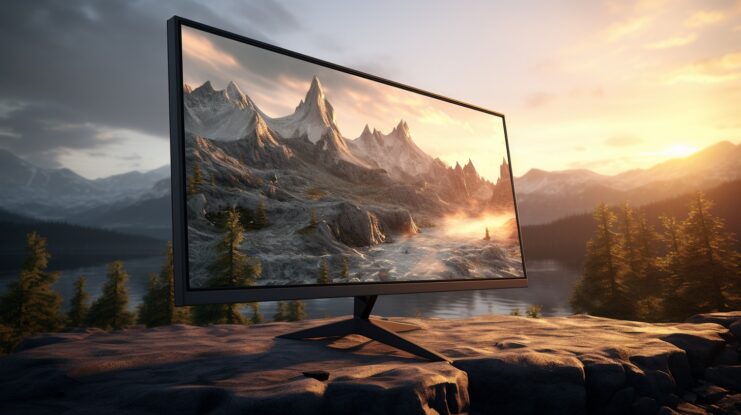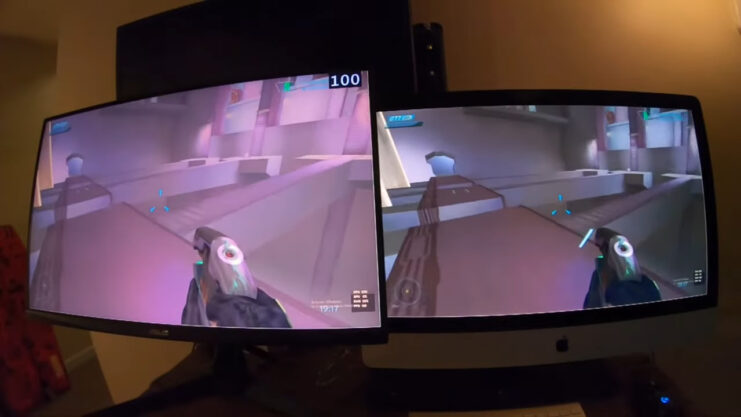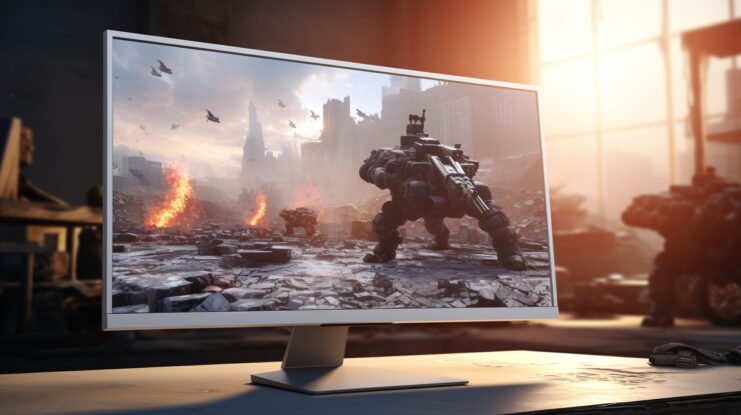Hey there, gamers and tech enthusiasts! Are you sitting in front of your trusty 60Hz monitor and wondering if it’s time for an upgrade? Or maybe you’re just curious about what all this refresh rate buzz is about? Well, you’ve come to the right place! Today, we’re diving into the exciting world of gaming monitors, specifically tackling the big question: Is 60Hz good enough for gaming?
Whether you’re a casual gamer who enjoys leisurely RPGs or a competitive speedster in the realm of first-person shooters, understanding the role of refresh rates in your gaming experience is crucial. So, grab your favorite snack, settle in, and let’s unravel the mysteries of 60Hz monitors together!
Refresh Rate
The refresh rate of a display refers to the number of times the screen updates its image per second. Measured in Hertz (Hz), this figure indicates how many frames per second (fps) the monitor can display. For instance, a 60Hz monitor refreshes the image on the screen 60 times per second.
The refresh rate is a critical factor in how smooth the motion appears on your screen. Higher refresh rates generally result in smoother motion, which is particularly noticeable in fast-paced scenarios like gaming or action-packed movies.
| Refresh Rate (Hz) | Typical Uses |
|---|---|
| 60Hz |
|
| 75Hz |
|
| 120Hz |
|
| 144Hz |
|
| 240Hz and above |
|
The Evolution of Gaming Displays
The evolution of gaming displays has been remarkable over the past few decades. Early computer monitors and home consoles were limited to refresh rates far below today’s standards, often around 30Hz. As technology advanced, the standard refresh rate for monitors increased to 60Hz, which has been the baseline for many years.
However, with advancements in graphics technology and gaming consoles, monitors with higher refresh rates, such as 120Hz, 144Hz, and even 240Hz, have become increasingly common. These higher refresh rates allow for smoother gameplay, which can be a significant advantage in fast-paced gaming genres.
60Hz in Gaming: Pros and Cons

Pros of 60Hz in Gaming
- Compatibility and Affordability: One of the main advantages of 60Hz monitors is their wide compatibility and affordability. Most media content, including games and videos, are optimized for 60Hz displays. These monitors are also more affordable compared to their higher Hz counterparts, making them a budget-friendly option for casual gamers.
- Sufficient for Casual Gaming: For casual gaming, especially in genres that do not require fast-paced action, such as strategy games or RPGs, a 60Hz monitor is generally sufficient. The difference in refresh rates is less noticeable in these genres, making 60Hz a viable option.
- Hardware Requirements: Running games at higher frame rates requires more powerful hardware. For gamers with mid-range or older PCs, a 60Hz monitor can be a practical choice as their systems may not be able to push higher frame rates consistently.
Cons of 60Hz in Gaming
- Limitations in Fast-Paced Games: In fast-paced games, such as first-person shooters or racing games, the limitations of a 60Hz monitor become more apparent. The lower refresh rate can result in motion blur and less fluid gameplay, which can be a disadvantage in competitive gaming.
- Frame Rate Cap: A 60Hz monitor can only display up to 60 frames per second, regardless of how powerful the gaming rig is. This cap means that even if the PC can render more frames, the monitor won’t display them, potentially leading to screen tearing and not utilizing the full potential of high-end gaming hardware.
Comparing 60Hz with Higher Refresh Rates

When comparing 60Hz monitors with those offering higher refresh rates, the differences become clear, especially in certain gaming scenarios. Monitors with refresh rates of 120Hz, 144Hz, or higher provide smoother motion, less blur, and improved responsiveness. This improvement is particularly noticeable in fast-paced games, where quick reflexes and split-second decisions are crucial.
In addition to smoother gameplay, higher refresh rates can also reduce eye strain and provide a more comfortable gaming experience, especially during extended gaming sessions. However, it is essential to note that the benefits of higher refresh rates are contingent on having hardware capable of pushing the higher frame rates.
Impact of Graphics Cards and Game Settings
The effectiveness of a 60Hz monitor in gaming is also influenced by the graphics card and game settings. A powerful graphics card capable of running games at high frame rates can provide a smooth gaming experience on a 60Hz monitor, albeit capped at 60fps. However, if the frame rate exceeds the refresh rate of the monitor, it can lead to issues like screen tearing, where the display shows parts of multiple frames at once.
Game settings also play a crucial role. Higher settings require more processing power, and on a 60Hz monitor, gamers might need to balance between graphic fidelity and performance. In some cases, reducing graphical settings can lead to a smoother experience if it allows the frame rate to remain consistently close to 60fps.
FAQs
Can using a 60Hz monitor affect my reaction time in competitive gaming?
While the monitor’s refresh rate doesn’t directly alter your reaction time, it can impact how quickly and smoothly motion is rendered on the screen. In competitive gaming, where every millisecond counts, a higher refresh rate monitor (like 120Hz or 144Hz) can provide a more up-to-date visual representation of the game, potentially aiding faster reaction times. A 60Hz monitor might slightly delay the visual feedback, which could impact split-second decision-making.
Will a 60Hz monitor cause eye strain during long gaming sessions?
Eye strain during gaming is influenced by several factors, including screen brightness, distance from the screen, and the refresh rate. A 60Hz monitor is generally not known to cause more eye strain than higher refresh rate monitors. However, smoother motion on higher refresh rate monitors can sometimes result in a more comfortable viewing experience during extended gaming sessions.
Is there a noticeable difference between 60Hz and 75Hz monitors for gaming?
The difference between 60Hz and 75Hz is relatively subtle but can be noticeable, especially in games that involve fast-moving visuals. The slight increase in smoothness and fluidity at 75Hz can enhance the gaming experience, though it’s not as significant a leap as moving from 60Hz to 120Hz or 144Hz.
Can I improve gaming performance on a 60Hz monitor by upgrading my graphics card?
Upgrading your graphics card can improve gaming performance in terms of higher frame rates and better graphics quality. However, on a 60Hz monitor, you will still be limited to seeing a maximum of 60 frames per second. So, while the game might run smoother, the visual benefits will be capped by the monitor’s refresh rate.
Are there specific games that benefit more from higher than 60Hz refresh rates?
Yes, fast-paced and competitive games like first-person shooters, racing games, and real-time strategy games benefit more significantly from higher refresh rates. These genres often require quick reflexes and rapid on-screen movements, where higher refresh rates provide smoother motion, reducing motion blur and screen tearing.
Does using a 60Hz monitor affect the lifespan of my gaming hardware?
The refresh rate of your monitor, such as 60Hz, does not directly affect the lifespan of your gaming hardware like the GPU or CPU. Hardware lifespan is more influenced by factors such as temperature management, usage intensity, and build quality. A 60Hz monitor simply limits the frame rate output visible to you, but it doesn’t impact the wear and tear of your hardware components.
Final Words
And that’s a wrap on our journey through the land of 60Hz gaming monitors! From dissecting what a refresh rate really means to weighing the pros and cons of sticking with our beloved 60Hz displays, we’ve covered a lot of ground.
Whether you’re more enlightened, contemplating an upgrade, or just satisfied knowing your good ol’ 60Hz buddy has still got your back, remember that gaming is all about enjoyment. So, keep having fun, stay awesome, and may your gaming adventures be as smooth as the frame rate of your dreams! Happy gaming, folks! 🎮🌟

